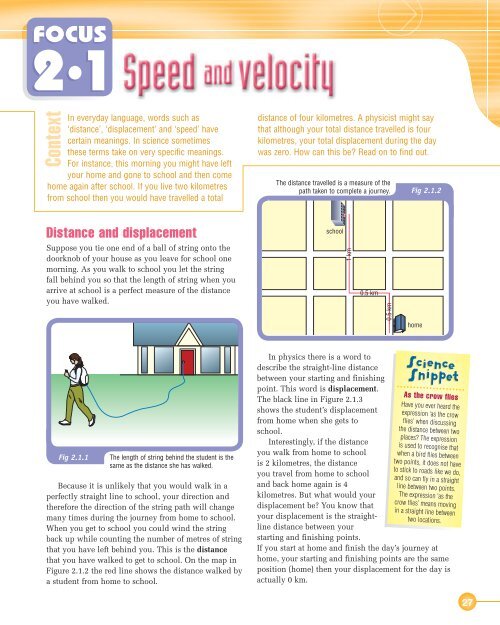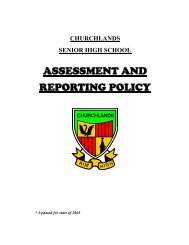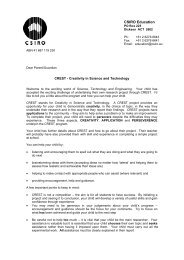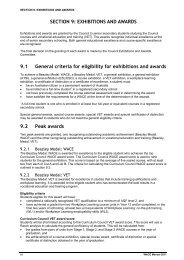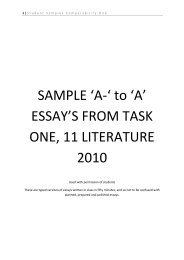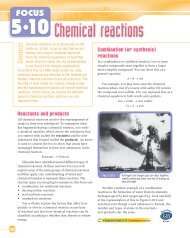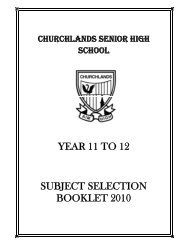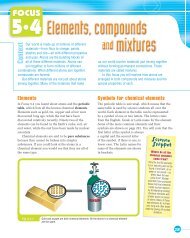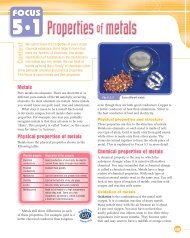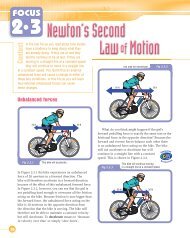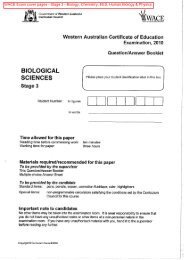Focus 2.1 - Speed and Velocity
Focus 2.1 - Speed and Velocity
Focus 2.1 - Speed and Velocity
Create successful ePaper yourself
Turn your PDF publications into a flip-book with our unique Google optimized e-Paper software.
FOCUS<strong>2.1</strong>In everyday language, words such as‘distance’, ‘displacement’ <strong>and</strong> ‘speed’ havecertain meanings. In science sometimesthese terms take on very specific meanings.For instance, this morning you might have leftyour home <strong>and</strong> gone to school <strong>and</strong> then comehome again after school. If you live two kilometresfrom school then you would have travelled a totalContextdistance of four kilometres. A physicist might saythat although your total distance travelled is fourkilometres, your total displacement during the daywas zero. How can this be? Read on to find out.The distance travelled is a measure of thepath taken to complete a journey.Fig <strong>2.1</strong>.2Distance <strong>and</strong> displacementSuppose you tie one end of a ball of string onto thedoorknob of your house as you leave for school onemorning. As you walk to school you let the stringfall behind you so that the length of string when youarrive at school is a perfect measure of the distanceyou have walked.school1 km0.5 km0.5 kmhomeFig <strong>2.1</strong>.1The length of string behind the student is thesame as the distance she has walked.Because it is unlikely that you would walk in aperfectly straight line to school, your direction <strong>and</strong>therefore the direction of the string path will changemany times during the journey from home to school.When you get to school you could wind the stringback up while counting the number of metres of stringthat you have left behind you. This is the distancethat you have walked to get to school. On the map inFigure <strong>2.1</strong>.2 the red line shows the distance walked bya student from home to school.In physics there is a word todescribe the straight-line distancebetween your starting <strong>and</strong> finishingpoint. This word is displacement.The black line in Figure <strong>2.1</strong>.3shows the student’s displacementfrom home when she gets toschool.Interestingly, if the distanceyou walk from home to schoolis 2 kilometres, the distanceyou travel from home to school<strong>and</strong> back home again is 4kilometres. But what would yourdisplacement be? You know thatyour displacement is the straightlinedistance between yourstarting <strong>and</strong> finishing points.If you start at home <strong>and</strong> finish the day’s journey atAs the crow fliesHave you ever heard theexpression ‘as the crowflies’ when discussingthe distance between twoplaces? The expressionis used to recognise thatwhen a bird flies betweentwo points, it does not haveto stick to roads like we do,<strong>and</strong> so can fly in a straightline between two points.The expression ‘as thecrow flies’ means movingin a straight line betweentwo locations.home, your starting <strong>and</strong> finishing points are the sameposition (home) then your displacement for the day isactually 0 km.27
<strong>Speed</strong> <strong>and</strong> velocity>>>Fig <strong>2.1</strong>.3The displacement of the student is thestraight-line distance from home to school.school1.6 kmhome<strong>Speed</strong> <strong>and</strong> velocityIn Western Australia, the speed limits on most cityroads range from 40 to 60 kilometres per hour. Theunit ‘kilometres per hour’ can be abbreviated indifferent ways, for instance km/h or just km h –1 . If youwere travelling at a constant 60 kilometres per hour, inyour first hour you would travel 60 kilometres. At theend of your second hour you would have travelled 120kilometres <strong>and</strong> so on. You might have heard of otherunits for describing speed, for instance miles per hour,but in physics we generally describe speed in units ofeither km/h or metres per second (m/s or m s –1 ).<strong>Speed</strong> can be thought of as how quickly an object’sdistance increases. <strong>Speed</strong> is the rate of change ofdistance. It can be calculated by using the formula:<strong>Speed</strong> = distancetimeorv = tsFor instance, in Figure <strong>2.1</strong>.2 the student walkeda distance of 2 kilometres from home to school.Calculate the speed the student walked at if it tookexactly half an hour to make the trip.v = ?s = 2 kmt = 0.5 hoursv =st=20. 5= 4 km/hThe student’s speed was 4 km/h.<strong>Velocity</strong> is similar to speed except it is a measureof how quickly displacement changes. <strong>Velocity</strong> isdefined as the rate of change of displacement.It can be calculated by using the formula<strong>Velocity</strong> = displacementtimeorv =stReferring back to Figure <strong>2.1</strong>.3, you can see thatalthough the student travelled a distance of2 kilometres to school, her displacement was only 1.6kilometres in a north-easterly direction.Her velocity is therefore:v =st=1.60 . 5= 3.2 km/hThe student’s velocity was 3.2 km/h north-east.Notice that when expressing displacement itis important to state the direction in which thedisplacement occurred. The direction runs from thestarting point to the finishing point.Comparing speed <strong>and</strong> velocityThe student featured in this <strong>Focus</strong> has been describedas travelling 2 kilometres to school <strong>and</strong> then 2kilometres back home. When the student has returnedhome her total distance travelled is 4 kilometresbut her total displacement during the day is0 kilometres. This information allows you tocalculate the student’s speed <strong>and</strong> velocity forher overall journey from home to school <strong>and</strong>back again, which took 1 hour.SPEEDv = tsPrac 1p. 31VELOCITYv =st<strong>Velocity</strong> = displacementtime0= 1= 4 km h –1 = 0 km h –1<strong>Speed</strong> = distancetime= 14Calculating displacement or timeYou can use the formula v = s / t to calculate thedisplacement of a moving object if you know itsvelocity over a given time. You first need to rearrangethe formula so that your equation allows you tosolve for displacement (s). You can use the solutions28
SSuppose you want to convert a velocity of 60 km/hinto m/s. The conversion chart above shows that toconvert from km/h to m/s requires you to divide thespeed by 3.6. This means that:<strong>Velocity</strong> in km h –1 =velocity in m/s3.6= 603.6= 16.7 m/svt<strong>2.1</strong>FOCUSFig <strong>2.1</strong>.4You can use this solutions triangle to solve fordisplacement (s). Place your finger over thevariable to be solved, which is S, leaving v tobe multiplied by t.Graphing motionThe slope of the graph shows thatthe cyclist was travelling at 5 ms –1 .Fig <strong>2.1</strong>.5triangle in Figure <strong>2.1</strong>.4 as a short cut if you find itdifficult to rearrange equations.Using the solutions triangle, put your finger overthe variable (quantity) you wish to solve for <strong>and</strong>then just read the position of the remaining variablesto determine their positions as denominator ornumerator.If you are given velocity <strong>and</strong> time <strong>and</strong> you wantto calculate displacement, the formula you will usebecomes:s = vt<strong>and</strong> if you are given displacement <strong>and</strong> velocity <strong>and</strong>you want to calculate time, the formula you will usebecomes:t = vsDisplacement (m)252015105run = 4 − 2 = 21 2 3 4 5Time (s)rise = 20 − 10 = 10slope = 10 = 52ExampleCalculate the displacement in metres of a train whichtravelled east for 30 minutes at a speed of 145 km/h.v = 145 km/ht = 0.5s = v × t= 145 × 0.5= 72.5 km eastConverting between units of speedIt will sometimes be necessary to convert from unitsof kilometres per hour to units of metres per second.You can use the simple method to convert betweenthese two units.km/h÷ 3.6× 3.6m/sFigure <strong>2.1</strong>.5 shows how displacement might changeas a cyclist travels at a constant velocity from hometo the shops. Notice that each second of travel resultsin an extra 5 metres of displacement. The velocity ofthe cyclist is therefore 5 metres per second (5 m/s).You can calculate the velocity of the cyclist on a graphlike this by calculating the gradient (slope) of the lineas shown on the graph. In maths you have probablylearnt that:Gradient (slope) =riserunFor this graph the slope is therefore 10 / 2 = 5.The slope of the line is equal to the velocity. So thevelocity is 5 m s –1 .A displacement–time graph like in Figure <strong>2.1</strong>.6indicates a vehicle that is stationary (not moving).This is because the rise is zero, so the slope is zero.Therefore the velocity is zero.29
<strong>Speed</strong> <strong>and</strong> velocity>>>DisplacementThe greater the slope ofdisplacement time graph therefore,the greater the velocity, as shownin Figure <strong>2.1</strong>.7.Fig <strong>2.1</strong>.7Prac 2p. 32A higher velocity would berepresented as a steeper slopeon a displacement–time graph.Fig <strong>2.1</strong>.6<strong>2.1</strong>FOCUSUse your bookTimeA horizontal line on a displacement–time graphmeans that displacement is not changingover time. This type of graph would thereforeindicate a velocity of 0 m/s.[ Questions ]Distance <strong>and</strong> displacement1 What is the difference between the quantities distance<strong>and</strong> displacement?2 Supposing that you were to walk 3 km north <strong>and</strong> then3 km east in 2 hours. What would be your distancetravelled <strong>and</strong> what would be your displacement fromyour starting point?3 A description of distance travelled might be 22 km.What extra bit of information is required when youdescribe displacement?<strong>Speed</strong> <strong>and</strong> velocity4 Write down the definitions of speed <strong>and</strong> velocity.5 What is the formula for velocity?6 Write down two units for speed.7 Calculate the speed <strong>and</strong> velocity for the journeyundertaken in question 2. Show your working out, likein the examples provided in this <strong>Focus</strong>.Calculating displacement or time8 Sam can maintain an average jogging speed of 4 km/h.Calculate the time it takes her to run the City to SurfMarathon (a total distance of 13.5 km) if she maintainsthis speed during the race.9 How far will a cyclist travel if he maintains a speed of5 m/s for 10 minutes?Converting between units of speed10 The speed limit on many West Australian roads is60 km/h. Convert this speed to a speed in m/s.11 A fighter aircraft flying a Mach 1 travels at 340 m/sDisplacement (m)Displacement10080604020higher velocityJanelower velocityTimeHomework book <strong>2.1</strong> Distance–time graphs12 How many times faster is an aircraft flying at thespeed of sound than a car on the freeway travellingat 100 km/h?Use your head13 The displacement–time graph shown in Figure <strong>2.1</strong>.8was produced when Jane, Indira <strong>and</strong> Charlotte ran the100-metre sprint as part of a science class activity.IndiraCharlotte5 10 15 20Time (s)Fig <strong>2.1</strong>.8 Graph for question 13a Who won the race <strong>and</strong> how can you tell?b Use the graph to calculate Indira’s velocity duringthe activity.c Who was the slowest runner in this race? How do(the speed of sound). What is its speed in km/h? you know?>>30
14 Draw a displacement time graph for someone whowalks 200 m north in 2 minutes, then runs 100 m southin 20 seconds, then walks 300 m north in 3 minutes.Investigating questions15 What is a sonic boom, when does it occur <strong>and</strong> whydoes it occur?16 How do radar guns or multa-nova cameras work?17 What is echolocation in bats or dolphins, <strong>and</strong> how doesthe animal use it?18 What does ‘sonar’ st<strong>and</strong> for, <strong>and</strong> where <strong>and</strong> how isit used?19 Find a way of measuring the velocity of amodel car or other vehicle over a set distance.You could use electronic devices. Constructor set up your timing device, then conduct DYOexperiments to measure the velocity of yourvehicle.<strong>2.1</strong>FOCUS<strong>2.1</strong>FOCUSPrac 1<strong>Focus</strong> <strong>2.1</strong>[ Practical activities ]Measuring velocityPurposeTo measure the velocity of a vehicle travelling at aconstant velocity by using a ticker tape timer.RequirementsTicker tape timer, ticker tape.Background on the ticker tape timerThe ticker tape timer is a device that causes an arm (seeFigure <strong>2.1</strong>.9) to vibrate up <strong>and</strong> down. Each time it movesdown it makes contact with a platform. Between the arm<strong>and</strong> the platform is carbon paper. When paper tape (calledticker tape) is pulled between the carbon paper <strong>and</strong> theplatform a mark is left on the tape then each time thevibrating arm makes contact with the platform. Because thearm vibrates 50 times per second, the spacing between dotsrepresents 1 /50 of a second.Procedurepaper ticker tapeabcSection of ticker tapeFig <strong>2.1</strong>.101 With the ticker tape timer try to pull the tape through ata steady speed. The section of tape that represents aconstant velocity will be indicated as a section of tapewith dots evenly spaced. Ensure that you produce atleast a 30 cm section of tape with dots evenly spaced.2 Get two other members of your group to do the same,but ensure that the speed at which they pull the tapethrough differs from yours.3 Draw two lines on the first <strong>and</strong> last dot of a section oftape where the dots are evenly spaced.4 Copy the following table into your notes.>>StudentDisplacement(s) in cmTime (t)in s<strong>Velocity</strong> incm/sFig <strong>2.1</strong>.9Ticker tape timer, with tape being pulledthrough by h<strong>and</strong>31
<strong>Speed</strong> <strong>and</strong> velocity>>>5 Measure the distance between the two lines. Thisis the displacement (s) that you will be using in yourcalculation. Record this in your table.6 Count the number of spaces between these two lines.Because each space represents a time of 1/50 (or 0.02)of a second, counting the number of spaces <strong>and</strong> thenmultiplying this number by 0.02 will give you the timetaken (t) for the second of tape between the lines to beproduced. Record this in your table.7 Use your measurements of s <strong>and</strong> t for each of the tapesto calculate the velocity with which you pulled each tapethrough the ticker tape timer. Record this in your table.Questions1 Why were you asked in this experiment to find a sectionof tape that showed dots spaced evenly?2 What might dots with increasing spacing represent?Prac 2<strong>Focus</strong> <strong>2.1</strong>Graphing motionPurposeTo collect <strong>and</strong> graph displacement <strong>and</strong> time datafor sprinters.RequirementsTrundle wheel or tape measure, 10 timekeeper volunteers,10 witch-hat markers or other markers, 10 stopclocks,two or three volunteer runners.Procedure1 Use the trundle wheel or tape measure to space outthe volunteer timekeepers at 10 metre intervals fromthe starting point. At least 50 metres of track <strong>and</strong>5 timekeepers are necessary to do this Prac. Eachtimekeeper will need a stopclock.2 The teacher raises their h<strong>and</strong> to indicate to thetimekeepers that the first runner is about to run.3 When the teacher drops their arm the first runner leavesthe 0 metre marker. At the same time each of thetimekeepers start their stopclocks.4 Each timekeeper stops their stopclock as the runnerpasses them. Copy the table below into your notes <strong>and</strong>record the time there.Displacement (m)0102030405060708090100Time to reach marker (s)Runner 1 Runner 2 Runner 3Fig <strong>2.1</strong>.11How to set up the experiment10 m5 Draw a graph of displacement–time for eachof the runners. Displacement should go onthe y-axis <strong>and</strong> time on the x-axis.6 Find the straightest section of each line onthis graph <strong>and</strong> calculate the gradient of eachof these lines.Questions1 What were the slopes of each of the lines onyour graph?2 Which of the runners ran with the greatestvelocity? How do you know this?3 Were there any parts of each of the graphswhere the plotted points did not producestraight lines? Was this constant velocity?32


